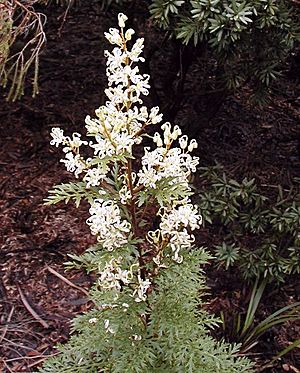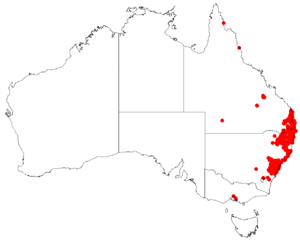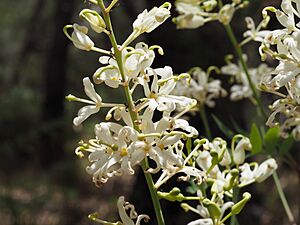Crinkle bush facts for kids
Quick facts for kids Crinkle bush |
|
|---|---|
 |
|
| Scientific classification | |
| Genus: |
Lomatia
|
| Species: |
silaifolia
|
 |
|
| Collections data from AVH | |
The Crinkle Bush (Lomatia silaifolia) is a cool plant from the Proteaceae family. It grows naturally in eastern Australia. You might know it as the parsley fern because its leaves look a lot like parsley! This small bush usually grows about 1 to 2 meters tall. In summer, it shows off pretty white flowers.
Contents
What Does Crinkle Bush Look Like?
The Crinkle Bush is a small, upright shrub. It grows about 1 to 2 meters (3 to 6.5 feet) tall. Its stems are smooth and have a slightly bluish-green color.
The leaves are very interesting! They are long, up to 35 to 50 centimeters (14 to 20 inches) long. They are also deeply divided, which makes them look a lot like the parsley you might use in cooking. This is why one of its common names is "parsley fern."
In summer, the Crinkle Bush produces beautiful white flowers. These flowers grow in tall clusters, sometimes reaching up to 45 centimeters (18 inches) high.
How Did Crinkle Bush Get Its Name?
The Crinkle Bush has a scientific name, Lomatia silaifolia. It was first described way back in 1793 by an English botanist named James Edward Smith. He first called it Embothrium silaifolium.
Later, in 1810, another botanist named Robert Brown gave it its current scientific name, Lomatia silaifolia. The "silaifolia" part of the name comes from the plant's leaves looking like those of the parsley genus called Silaum.
Besides its scientific name, the Crinkle Bush has many common names. People call it crinkle bush, parsley fern, wild parsley, and fern-leaved lomatia.
Scientists have also found that the Crinkle Bush can sometimes mix with other Lomatia species, like the Tree Lomatia and L. myricoides. This mixing is called hybridization. Even with this mixing, each type of Lomatia is still unique enough to be its own species.
Where Does Crinkle Bush Grow?
The Crinkle Bush is found in many parts of eastern Australia. You can see it east of the Great Dividing Range. It grows in places like the Blackdown Tableland National Park in central Queensland. It's also found from Gympie in south-east Queensland down to the New England area of north-eastern New South Wales. Further south, it grows from the Hunter Region to Jervis Bay in central New South Wales.
This plant likes to grow in open forests, often on sandy soils. It grows as a smaller shrub under taller trees. Some of the trees it grows near include the red bloodwood, turpentine, blackbutt, and Sydney peppermint.
Crinkle Bush in Nature
Crinkle Bush plants can live for a long time, sometimes over 60 years! If there's a bushfire, these plants are tough. They can grow back from their base, which helps them survive.
Some animals like to eat the leaves of the Crinkle Bush. For example, swamp wallabies sometimes munch on them.
Growing Crinkle Bush in Your Garden
The Crinkle Bush was first grown in gardens in England in 1808. It was noted that it didn't flower often and needed a special greenhouse to grow well there.
However, its unique leaves and interesting fruits make it a great plant for gardens. It's quite easy to grow from seeds. It can also handle many different types of soil and growing conditions, making it a good choice for many gardens.
Gallery
-
Leaves, Cranbourne Botanic Gardens






